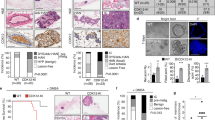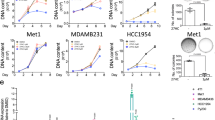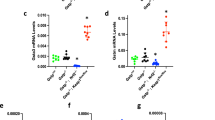Abstract
Vitamin A deficiency (VAD) is associated with increased susceptibility to carcinogenesis in animal models and elevated risk for a number of human cancers. Here, we found that CYP26A1, the gene encoding a cytochrome P450 enzyme specifically involved in metabolic inactivation of retinoic acid (RA), the most active vitamin A derivative, is highly expressed in 42% (27/65) of primary breast cancers. We also showed that enhanced expression of CYP26A1 suppresses cellular responses to anoikis and consequently promotes anchorage-independent growth. This transformed phenotype was sufficient to markedly increase tumorigenic and metastatic potential. Suppression of CYP26A1 significantly reversed the CYP26A1-mediated oncogenic characteristics, suggesting a direct link between intracellular RA status and tumorigenicity. Our observations provide strong evidence for oncogenic and cell survival properties of CYP26A1 in carcinogenesis, and suggest mechanisms whereby VAD might promote cancer development.
This is a preview of subscription content, access via your institution
Access options
Subscribe to this journal
Receive 50 print issues and online access
$259.00 per year
only $5.18 per issue
Buy this article
- Purchase on Springer Link
- Instant access to full article PDF
Prices may be subject to local taxes which are calculated during checkout






Similar content being viewed by others
Accession codes
References
Abu-Abed S, Dolle P, Metzger D, Wood C, MacLean G, Chambon P et al. (2001). The retinoic acid-metabolizing enzyme, CYP26A1, is essential for normal hindbrain patterning, vertebral identity, and development of posterior structures. Genes Dev 15: 226–240.
Altucci L, Gronemeyer H . (2001). The promise of retinoids to fight against cancer. Nat Rev Cancer 1: 181–193.
Chambon P . (1996). A decade of molecular biology of retinoic acid receptors. FASEB J 10: 940–954.
Chang CL, Hong E, Lao-Sirieix P, Fitzgerald RC . (2008). A novel role for the retinoic acid-catabolizing enzyme CYP26A1 in Barrett's associated adenocarcinoma. Oncogene 27: 2951–2960.
Elliott BE, Maxwell L, Arnold M, Arnold M, Wei WZ, Miller FR . (1988). Expression of epithelial-like markers and class-I major histocompatibility antigens by a murine carcinoma growing in the mammary gland and in metastases. Cancer Res 48: 7237–7245.
Evan GI, Vousden KH . (2001). Proliferation, cell cycle, and apoptosis in cancer. Nature 411: 342–348.
Fenaux P, Degos L . (1997). Differentiation therapy for acute promyelocytic leukemia. N Engl J Med 337: 1076–1077.
French AL, Kirstein LM, Massad LS, Semba RD, Minkoff H, Landesman S et al. (2000). Association of vitamin A deficiency with cervical squamous intraepithelial lesions in human immunodeficiency virus-infected women. J Infect Dis 182: 1084–1089.
Gozani O, Boyce M, Yoo L, Karuman P, Yuan J . (2002). Life and death in paradise. Nat Cell Biol 4: E159–E162.
Kizaki M, Ueno H, Matsushita H, Takayama N, Muto A, Awaya N et al. (1997). Retinoid resistance in leukemic cells. Leuk Lymphoma 25: 427–434.
Lotan R . (1996). Retinoids in cancer chemoprevention. FASEB J 10: 1031–1039.
Loudig O, Babichuk C, White J, Abu-Abed S, Mueller C, Petkovich M . (2000). Cytochrome P450RAI (CYP26) promoter: a distinct composite retinoic acid response element underlies the complex regulation of retinoic acid metabolism. Mol Endocrinol 14: 1483–1497.
Loudig O, Maclean GA, Dore NL, Luu L, Petkovich M . (2005). Transcriptional co-operativity between distant retinoic acid response elements in regulation of Cyp26A1 inducibility. Biochem J 392 (Pt 1): 241–248.
Osanai M, Murata M, Nishikiori N, Chiba H, Kojima T, Sawada N . (2006). Epigenetic silencing of occludin promotes tumorigenic and metastatic properties of cancer cells via modulations of unique sets of apoptosis-associated genes. Cancer Res 66: 9125–9133.
Osanai M, Petkovich M . (2005). Expression of the retinoic acid metabolizing enzyme, CYP26A1 limits programmed cell death. Mol Pharmacol 67: 1808–1817.
Petkovich M . (2001). Retinoic acid metabolism. J Am Acad Dermatol 45: S136–S142.
Shelton DN, Sandoval IT, Eisinger A, Chidester S, Ratnayake A, Ireland CM et al. (2006). Up-regulation of CYP26A1 in adenomatous polyposis coli-deficient vertebrates via a WNT-dependent mechanism: implications for intestinal cell differentiation and colon tumor development. Cancer Res 66: 7571–7577.
Sobin LH, Wittekind Ch . (2002). TNM Classification of Malignant Tumours. John Wiley & Sons: New Jersey.
Sonneveld E, van den Brink CE, van der Leede BM, Schulkes RK, Petkovich M, van der Burg M et al. (1998). Human retinoic acid (RA) 4-hydroxylase (CYP26) is highly specific for all-trans-RA and can be induced through RA receptors in human breast and colon carcinoma cells. Cell Growth Diff 9: 629–637.
Tavassoli FA, Devilee P . (2003). Pathology and Genetics of Tumours of the Breast and Female Genital Organs. IARC Press: Lyon.
Van heusden J, Wouters W, Ramaekers FC, Krekels MD, Dillen L, Borgers M et al. (1998). The antiproliferative activity of all-trans-retinoic acid catabolites and isomers is differentially modulated by liarozole-fumarate in MCF-7 human breast cancer cells. Br J Cancer 77: 1229–1235.
Wang Z, Boudjelal M, Kang S, Voorhees JJ, Fisher GJ . (1999). Ultraviolet irradiation of human skin causes functional vitamin A deficiency, preventable by all-trans retinoic acid pre-treatment. Nat Med 5: 418–422.
White JA, Backett-Jones B, Guo YD, Dilworth FJ, Bonasoro J, Jones G et al. (1997). cDNA cloning of human retinoic acid-metabolizing enzyme (hP450RAI) identifies a novel family of cytochromes P450. J Biol Chem 272: 18538–18541.
Wolbach SB, Howe PR . (1925). Tissue changes following deprivation of fat-soluble A vitamin. J Exp Med 43: 753–777.
Acknowledgements
This study was supported by a Grant-in-Aid for Scientific Research from the Japan Society for the Promotion of Science. We thank doctors at the Department of Surgical Pathology for providing archival formalin-fixed, paraffin-embedded tissue specimens and for their pathological diagnoses, and doctors at the Department of Surgical Oncology and Gastroenterological Surgery for scientific cooperation by providing surgically resected materials in patients with breast cancer, as well as the Animal Care Facility (Sapporo Medical University School of Medicine, Sapporo, Japan).
Author information
Authors and Affiliations
Corresponding author
Additional information
Supplementary Information accompanies the paper on the Oncogene website (http://www.nature.com/onc)
Rights and permissions
About this article
Cite this article
Osanai, M., Sawada, N. & Lee, GH. Oncogenic and cell survival properties of the retinoic acid metabolizing enzyme, CYP26A1. Oncogene 29, 1135–1144 (2010). https://doi.org/10.1038/onc.2009.414
Received:
Revised:
Accepted:
Published:
Issue Date:
DOI: https://doi.org/10.1038/onc.2009.414
Keywords
This article is cited by
-
Retinoic acid metabolism in cancer: potential feasibility of retinoic acid metabolism blocking therapy
Medical Molecular Morphology (2023)
-
CYP2C9 inhibits the invasion and migration of esophageal squamous cell carcinoma via downregulation of HDAC
Molecular and Cellular Biochemistry (2021)
-
Targeting cytochrome P450-dependent cancer cell mitochondria: cancer associated CYPs and where to find them
Cancer and Metastasis Reviews (2018)
-
Elevated expression of the retinoic acid-metabolizing enzyme CYP26C1 in primary breast carcinomas
Medical Molecular Morphology (2016)
-
Increased expression of the retinoic acid-metabolizing enzyme CYP26A1 during the progression of cervical squamous neoplasia and head and neck cancer
BMC Research Notes (2014)



